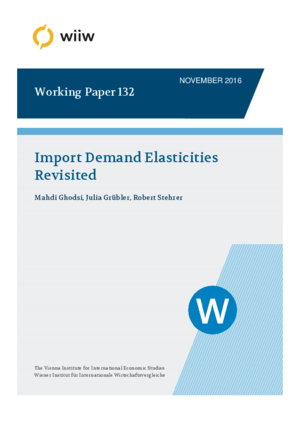Import Demand Elasticities Revisited
Mahdi Ghodsi, Julia Grübler and Robert Stehrer
wiiw Working Paper No. 132, November 2016
32 pages including 6 Tables and 6 Figures
Abstract
In this paper, we present import demand elasticities estimated for 167 countries over 5,124 products at the six-digit level of the Harmonised System. Following the semiflexible translog GDP function approach proposed by Kee et al. (2008), we estimate unilateral import demand elasticities for the period 1996-2014. Results are differentiated by country and product characteristics. South Asia and North America are associated with the most elastic import demand. Countries exhibiting the highest average elasticities belong to the economically most important countries in their respective regions, while countries with the lowest import demand elasticities are typically small island states. Import-weighted results suggest that especially countries rich in natural resources – particularly fossil fuels – are facing an inelastic import demand, with the agri-food sector for these states being more price-responsive than the manufacturing sector. Demand is found to be least price-sensitive for machinery and electrical equipment, and most price-elastic for the energy sectors. Distinguishing between the use of products, the highest import demand elasticities are associated with intermediate goods, which appears particularly noteworthy in the context of an increasing importance of global value chains, the global trade slowdown since 2011 and ongoing negotiations of mega-regional trade deals.
Keywords: international trade, import demand, elasticity
JEL classification: D12, F14
Countries covered: non specific
Research Areas: International Trade, Competitiveness and FDI
